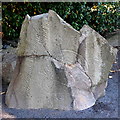1
Brandsbutt Stone
The Brandsbutt Stone carved between 500 and 900 AD. Note the mound behind the lamp post.
Image: © stephen samson
Taken: 20 Oct 2006
0.06 miles
2
Brandsbutt Stone
The stone and its neighbours once formed part of a stone circle. The circumference of the circle was marked by a circle of cobbles laid in the grass, but the grass, having this unfortunate tendency to keep growing, has now all but hidden the cobbles. You can just about make out a groove in the grass from lower left to the centre of this shot. The information board is clearly visible, and the Brandsbutt Stone itself is in the semi-shade to the right of it. See https://canmore.org.uk/site/18894/brandsbutt-inverurie-symbol-stone for more information.
Image: © Anne Burgess
Taken: 25 Feb 2016
0.07 miles
3
Brandsbutt Stone Circle
Some of the Pictish stones that were recovered from a stone dyke in 1900. The circle was destroyed many years before. They now lie surrounded by a new housing scheme.
Image: © stephen samson
Taken: 20 Oct 2006
0.08 miles
4
Brandsbutt Stone
This stone has been restored to some extent after its removal
from a dyke around the year 1900. It's a Pictish Symbol Stone. See http://www.aberdeenshire.gov.uk/archaeology/sites/pictish/bransbutt.asp
Image: © stephen samson
Taken: 20 Oct 2006
0.09 miles
5
Suburban corner (autumn trees)
Gordon Terrace meets Brankie Road in the endless Inverurie suburbs.
Image: © Bill Harrison
Taken: 30 Sep 2017
0.09 miles
6
The Brandsbutt Pictish Stone
Broken and re-assembled.
It bears several standard symbols found on pictish stones including:
a V rod, a Z rod a crescent and a serpent.
In addition there is an ogham inscription: IRATADDOARENS
thought to mean Eddarrnon, possibly St. Ethernanus.
Image: © Bob Embleton
Taken: 11 Aug 2011
0.09 miles
7
Brandsbutt Stone
A stone of many pieces this Pictish stone was recovered from farmland as pieces and carefully reassembled.
Image: © Andrew Wood
Taken: 6 Oct 2008
0.09 miles
8
Brandsbutt Stone
The Brandsbutt stone bears Pictish carvings and an Ogham inscription. It was found broken into pieces in a field was but has been reassembled. See https://canmore.org.uk/site/18894/brandsbutt-inverurie-symbol-stone for more information.
Image: © Anne Burgess
Taken: 25 Feb 2016
0.09 miles
9
Brandsbutt Stone
The stone is a Class 1 stone, which means that it has incised symbols but no cross or relief carving. The symbols are a serpent and Z-rod, and above it a crescent and V-rod. On the left-hand edge of the stone there is an Ogham inscription. See https://canmore.org.uk/site/18894/brandsbutt-inverurie-symbol-stone for more information.
Image: © Anne Burgess
Taken: 25 Feb 2016
0.09 miles
10
Another view of the Brandsbutt Stone
This fine symbol stone was blown up in the 19th Century and the fragments used to construct a dyke but most of it was later reassembled with cement infills. Until recently it was in open farmland, but is now surrounded by suburban housing. It is decorated with Pictish crescent and V-rod and a serpent and Z-rod symbols as well as Ogam characters. Canmore reference 18894: https://canmore.org.uk/site/18894/brandsbutt-inverurie-symbol-stone . For more, see Allen and Anderson, Early Christian Monuments of Scotland, vol. 3, p. 506, available as a download from archive.org
Image: © Bill Harrison
Taken: 30 Sep 2017
0.09 miles











